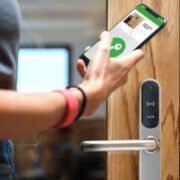It’s possible to open and close your windows without touching them. That’s thanks to automation. For such to be achievable, you need a reliable motion mechanism. Linear actuators prove to be one of the best options you can consider.
Before you set out constructing your windows with linear actuators, there are some factors to consider. The window type is essential and you must follow the right installation steps. Afterward, there are some safety considerations to keep in mind. We’ll discuss them all in this piece.
What are Linear Actuators?
In simple words, linear actuators are devices designed to convert rotational motion into linear motion. As a result, they are essential for various applications — including remote window opening. The devices typically feature a motor and a lead screw. Rotational force comes from the motor, and is then transformed into straight motion by the screw.
Linear actuators are available in different types. Notably, each works for specific purposes. Electric linear actuators, however, are more common for remote window applications. That’s due to their efficiency and ease of control. In particular, they operate quietly and provide precise movement. So, they’re ideal for adjusting window positions.
In remote window opening systems, the actuator also allows for controlled and smooth movement. They enable windows to open or close accurately. One advantage is that the setup eliminates the need for manual effort. It provides convenience, especially for windows in hard-to-reach areas.
If you plan to use actuators for remote windows at home, the task shouldn’t be difficult. However, you should know more about managing the devices. For instance, you can learn about replacing an actuator, as it may be needed subsequently.
Advantages of Remote Window Opening
Setting up remote window opening with linear actuators introduces many benefits. Most of it improves living spaces. You can check out some of the main advantages below.
- Convenience: With the push of a button or a click on a remote, you can effortlessly open or close windows. As stated, it ends the need for manual operation.
- Accessibility: This is a benefit in spaces with high or difficult-to-reach windows. The remote opening ensures access without needing to use ladders or other tools.
- Ventilation Control: Linear actuators allow precise adjustment of window positions. Therefore, they let you regulate airflow and ventilation to your preferences.
- Enhanced Safety: With remote window opening, you remove the need for reaching out to windows in harmful positions. That promotes safety as it reduces the risk of accidents.
- Smart Integration: Actuators are automation devices. So, you can integrate them into smart home setups. With that, you can synchronize your windows with other smart devices at home.
- Energy Efficiency: By opening windows with precision, you can optimize natural lighting and ventilation. It helps with energy efficiency by reducing reliance on artificial lighting and air conditioning.
Types of Windows Compatible with Linear Actuators
Linear actuators are highly versatile. For that reason, they can work with various window types, Here are some common compatible options to consider.
- Awning Windows: Linear actuators can work with awning windows. The motion devices facilitate automated opening and closing for proper ventilation.
- Casement Windows: These windows are hinged on one side. So, they can benefit from linear actuators and provide users with easy control.
- Sliding Windows: Linear motion devices can easily adapt to sliding windows. They help optimize horizontal movement for convenience.
- Double-Hung Windows: For windows with two vertically sliding sashes, linear actuators introduce a modern touch. They do so by automating the raising and lowering of each sash.
- Skylights: If you have skylights, linear actuators can ensure operating the elevated windows with ease.
- Fixed Windows: Even fixed or picture windows can benefit from linear actuators. Particularly, the devices allow access to hard-to-reach places.
Installing Actuators in Windows for Remote Opening
For the installation, the process is straightforward. However, you have to follow the right steps to avoid any confusion. You can complete the task with the below instructions.
Assess the Window Type
You should first assess the specific type of window. This is to ensure it’s compatible with linear actuators. While at it, measure the dimensions and check for any modifications. All these will guarantee a seamless integration.
Choose the Right Actuator
Now, get a linear actuator that matches the window’s size and weight. It’s important that the actuator’s specifications align with the functionality you want to achieve.
Install the Mounting Brackets
Here, you’ll attach the mounting brackets to the window frame and the actuator. This step ensures you have a secure foundation. It’ll allow the actuator operate effectively.
Connect a Power Source
The linear actuator needs to connect to a power source to operate. This can be straightforward with direct power supply. But you can also use a control unit or a different automation system.
Secure the Wiring and Components
What to do here is to secure all wiring and components. The step helps prevent any interference as the window operates. Particularly, conceal wires. The advantage is that you get a neat and tidy appearance.
Integrate the Remote Control
If you’re using a remote control, you should connect it to the setup. Such a connection will allow you to operate the window with ease from a distance.
Some Safety Tips to Consider
As we’ve explained, using linear actuators for remote window opening has many advantages. However, you still need to ensure safety. Here’s what you can do:
- Ensure the mounting brackets and fixtures securing the linear actuators to the window frame are robust and. Also keep them well-maintained. It prevents dislodging and other potential failures.
- Install motion sensors to spot obstacles as the window’s moves. This will automatically stop the actuator if there’s any obstruction.
- Include a manual override option that allows you operate the window by hand. It helps in case of power failures or system malfunctions.
- Have a routine maintenance schedule. During the time, inspect the linear actuators and check for wear and tear. Also lubricate the moving parts, and address any issue quickly so it doesn’t get worse.
Conclusion
Opening and closing your window remotely has many benefits. Above all, it introduces convenience and better performance. Thankfully, you can arrange such a setup with ease using a linear actuator. Simply follow the instructions discussed in this article.














Comments